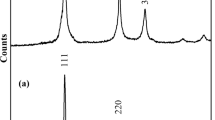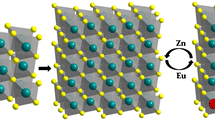Abstract
The influence of the properties of the environment interacting with the surface of crystal phosphor on its radiative recombination has been considered. The influence of treatment with hexane and toluene on the state of the surface of powdery ZnS:Cu:Cl has been investigated. It has been shown that treatment with hexane and toluene leads to an increase in the photoluminescence intensity of the luminophor under investigation. On the basis of the analysis of the luminescence and photoluminescence excitation spectra, a model explaining the change in the concentration of radiationless recombination centers on the surface of powdery ZnS:Cu:Cl is proposed. It has been shown that the interaction between the above organic liquids and the luminophor surface leads to its passivation and improvement of the luminescent properties of the luminophor.
Similar content being viewed by others
References
A. V. Rzhanov (Ed.), Some Problems of the Physics and Chemistry of the Surface of Semiconductors [in Russian], Nauka, SO, Novosibirsk (1972).
S. R. Morrison, The Chemical Physics of Solid Surfaces [Russian translation], Mir, Moscow (1980).
Yu. Yu. Bacherikov, I. S. Golovina, N. V. Kitsyuk, et al., in: Proc. Conf. “Structural Relaxation in Solids” [in Russian], May 13–14, 2003, Vinnitsa, Ukraine (2003), pp. 180–182.
N. K. Morozova and V. A. Kuznetsov, Zinc Sulf. Its Obtaining and Optical Properties [in Russian], Nauka, Moscow (1987).
N. K. Popova, A. V. Lavrov, and M. V. Fok, Izv. Akad. Nauk SSSR, Ser. Fizicheskaya, 33, No. 6, 157–165 (1969).
A. M. Gurvich, Introduction to the Physical Chemistry of Crystal Phosphors [in Russian], Vysshaya Shkola, Moscow (1982).
I. A. Kirovskaya, Neorg. Mater., 25, No. 9, 1472–1476 (1989).
V. V. Perekalin and S. A. Zonis, Organic Chemistry [in Russian], 2nd rev. augm. edn., Prosveshchenie, Moscow (1973).
J. L. Gland and G. A. Samorjai, Surface Sci., 41, 387–402 (1974).
W. H. Weinberg, H. A. Deans, and R. P. Merrill, Surface Sci., 41, 312–336 (1974).
S. C. Chang and P. Mark, Surface Sci., 46, 293–300 (1974).
F. F. Vol’kenshtein, Physical Chemistry of the Surface of Semiconductors [in Russian], Nauka, Moscow (1973).
A. I. Ansel’m, Introduction to the Theory of Semiconductors [in Russian], Nauka, Moscow (1978).
Yu. Yu. Lur’e, Handbook of Analytical Chemistry [in Russian], Khimiya, Moscow (1965).
Author information
Authors and Affiliations
Corresponding author
Additional information
__________
Translated from Zhurnal Prikladnoi Spektroskopii, Vol. 72, No. 6, pp. 799–804, November–December, 2005.
Rights and permissions
About this article
Cite this article
Bacherikov, Y.Y., Okhrimenko, O.B., Tomashik, Z.F. et al. Activation of zinc sulfide luminescence by modifying its surface by organic solvents. J Appl Spectrosc 72, 877–882 (2005). https://doi.org/10.1007/s10812-006-0019-y
Received:
Issue Date:
DOI: https://doi.org/10.1007/s10812-006-0019-y




